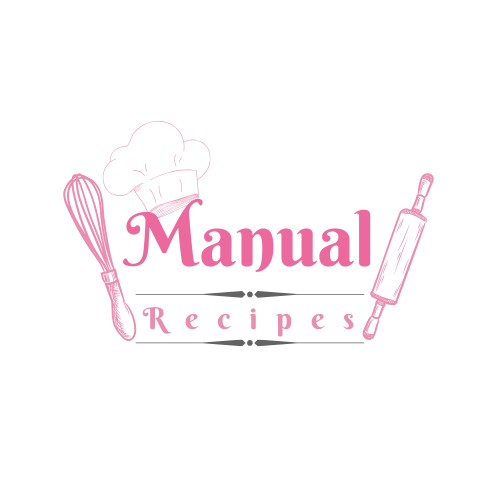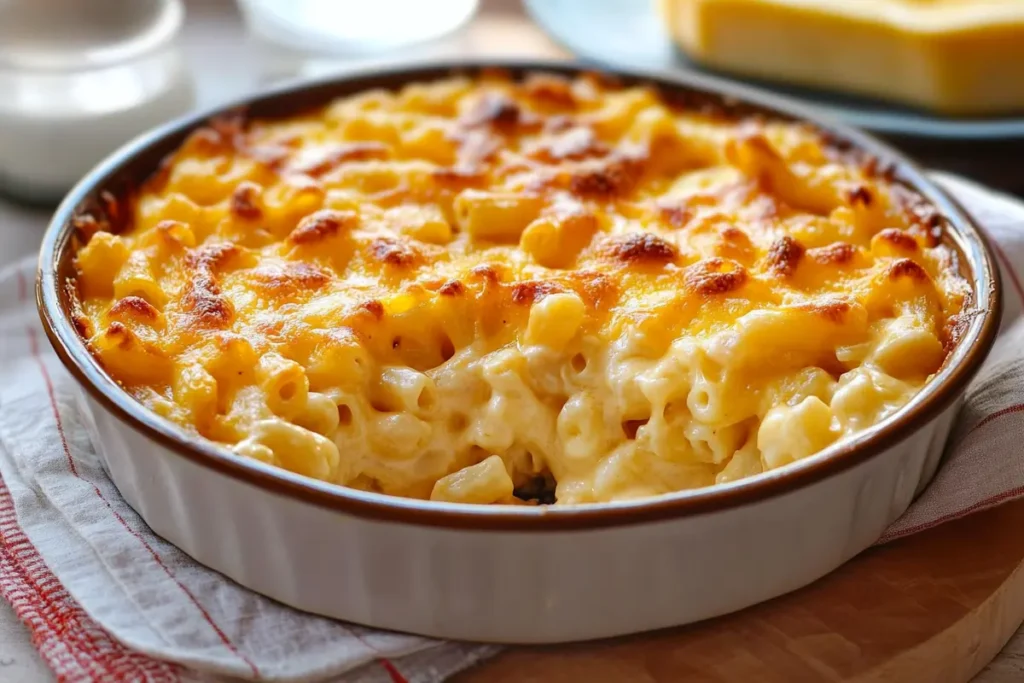Creamy, cheesy, and irresistibly delicious—old fashioned baked macaroni and cheese has been a timeless staple in households across generations. This recipe embodies everything you crave in comfort food: gooey cheese, tender pasta, and a golden, crispy topping that satisfies every bite. Whether it’s served as the star of a cozy dinner or a side dish at festive gatherings, this dish never fails to bring people together.
From its humble beginnings as a European favorite to its evolution into a cherished American classic, macaroni and cheese has a rich history. And while modern shortcuts abound, there’s nothing quite like making it the old-fashioned way.
Table of Contents
Old Fashioned Baked Macaroni and Cheese: A Timeless Comfort Food
What Makes This Dish Special?
At its heart, old fashioned baked macaroni and cheese is more than just food—it’s a comforting, nostalgic hug in a bowl. The combination of a rich cheese sauce and perfectly cooked macaroni baked to perfection makes it hard to resist. Families have passed down variations of this recipe for decades, each putting their unique spin on the classic.
This dish stands out for its simple ingredients, which come together in magical ways. It’s easy to make, highly customizable, and works well for everything from weeknight dinners to holiday feasts. The crispy breadcrumb topping? That’s just the cherry on top.
Brief History of Macaroni and Cheese
Tracing the origins of macaroni and cheese takes us back to Europe, where pasta and cheese were paired centuries ago. According to culinary historians, the first recorded recipes appeared in Italian cookbooks, while variations eventually made their way into England. By the 18th century, macaroni and cheese began gaining popularity in the United States.
Thomas Jefferson is often credited for bringing macaroni and cheese to America after being introduced to it in France. He even brought back a pasta machine to recreate the dish! Over time, baked macaroni and cheese became a staple of Southern cooking, where families began enhancing it with rich flavors and baked textures.
Why People Love the Old-Fashioned Version
Sure, you can find boxed mac and cheese, but the old-fashioned version? Oh, it’s in a league of its own. It skips preservatives and artificial powders, opting for real, fresh ingredients instead. The result is a dish that’s not only tastier but also feels homemade, hearty, and satisfying.
When you make old fashioned baked macaroni and cheese, you get full control over every element—from the type of cheese to the consistency of the sauce to how much crunch you want on top. Plus, it’s an absolute crowd-pleaser, earning a spot in almost every recipe book and family dinner table.
Key Ingredients and Tools
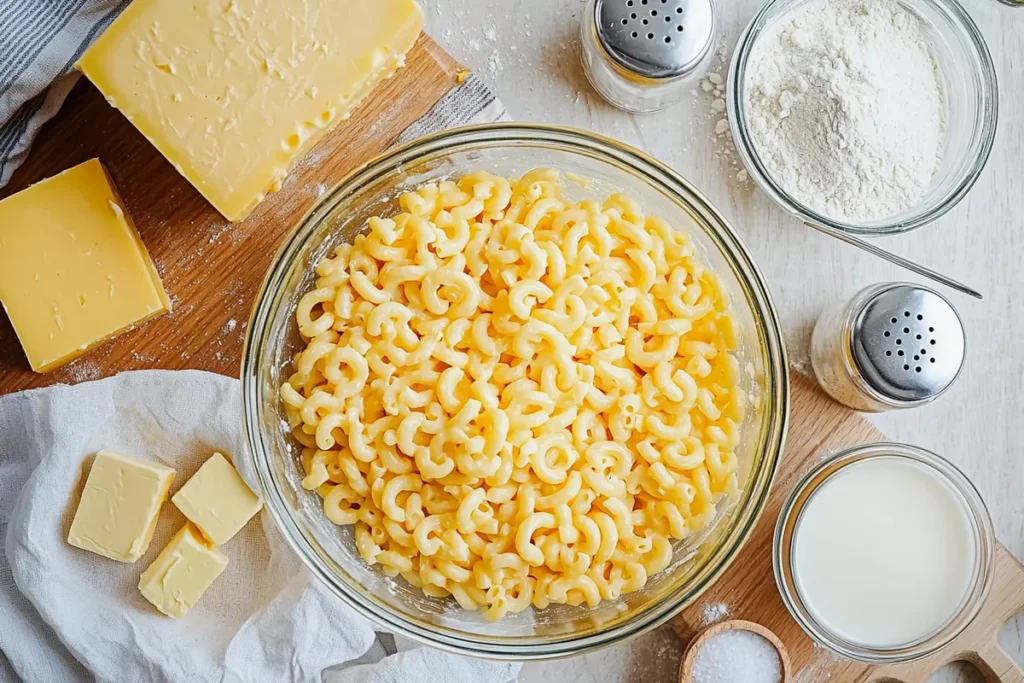
Essential Ingredients for Old Fashioned Baked Macaroni and Cheese
The beauty of old fashioned baked macaroni and cheese lies in its simplicity. Each ingredient contributes something special to the final dish, so choose wisely.
Types of Pasta to Use
Elbow macaroni is the classic choice, thanks to its ability to hold onto the creamy cheese sauce. However, don’t hesitate to experiment with alternatives like shells, cavatappi, or penne. These shapes create delightful pockets that trap the sauce, ensuring every bite is flavorful.
Cheese Selection: Cheddar, Colby, Gruyère, or a Blend
Cheese is the soul of this dish, so go for high-quality varieties. Sharp cheddar delivers the bold, tangy flavor people expect. For a creamier texture, mix in Colby, Monterey Jack, or even Gruyère. A blend of cheeses often strikes the perfect balance of richness and meltability.
Importance of Milk, Cream, and Butter in the Recipe
The combination of milk and cream forms the foundation of the cheese sauce, creating its velvety consistency. Butter adds depth and richness to the flavor, while also acting as the base for the roux.
Role of Flour for the Roux and Breadcrumbs for Topping
Flour is critical for thickening the cheese sauce, ensuring it clings to the pasta perfectly. As for breadcrumbs, they provide that irresistible crunch on top. Panko breadcrumbs, in particular, deliver the crispiest results.
Recommended Kitchen Tools
Creating a flawless old fashioned baked macaroni and cheese requires the right tools to make the process smooth and enjoyable.
Baking Dish Options: Glass vs. Ceramic
Choose a sturdy baking dish that retains heat evenly. Glass dishes are excellent for monitoring the bubbling sauce and browning breadcrumbs. Ceramic dishes, on the other hand, are ideal for even heat distribution and a rustic presentation.
Tools for a Smooth Cheese Sauce
To make a silky cheese sauce, a whisk is non-negotiable. It ensures the roux remains lump-free and helps blend the cheese into the sauce seamlessly. A sturdy saucepan is equally important for steady heat control.
Why a Cheese Grater Is Essential for Fresh Flavor
While pre-shredded cheese might be convenient, it often contains anti-caking agents that hinder melting. A cheese grater ensures freshly shredded cheese, leading to a smoother, creamier sauce. Plus, freshly grated cheese packs more flavor!
How to Make Old Fashioned Baked Macaroni and Cheese
When it comes to preparing old fashioned baked macaroni and cheese, every step counts toward achieving that perfectly creamy, golden-baked dish that everyone loves. Follow this step-by-step guide to master the recipe from start to finish.
Prepping the Pasta
The foundation of any good old fashioned baked macaroni and cheese lies in the pasta. Getting this step right ensures your dish starts off on the right foot.
Choosing the Right Pasta Shape
While elbow macaroni is the go-to choice, other pasta shapes like cavatappi, shells, or rotini work just as well. The key is choosing pasta with ridges or curves that can hold onto the rich cheese sauce. Avoid long noodles like spaghetti or fettuccine, as they don’t complement the dish’s texture.
Cooking Pasta Al Dente for the Perfect Texture
Cook your pasta just until al dente, or slightly firm to the bite. Overcooking can lead to mushy pasta, which won’t hold up during baking. To achieve this, boil the pasta in salted water for 1-2 minutes less than the package instructions recommend. Drain it well and toss it lightly with a drizzle of oil to prevent sticking while you prepare the sauce.
Crafting the Cheese Sauce
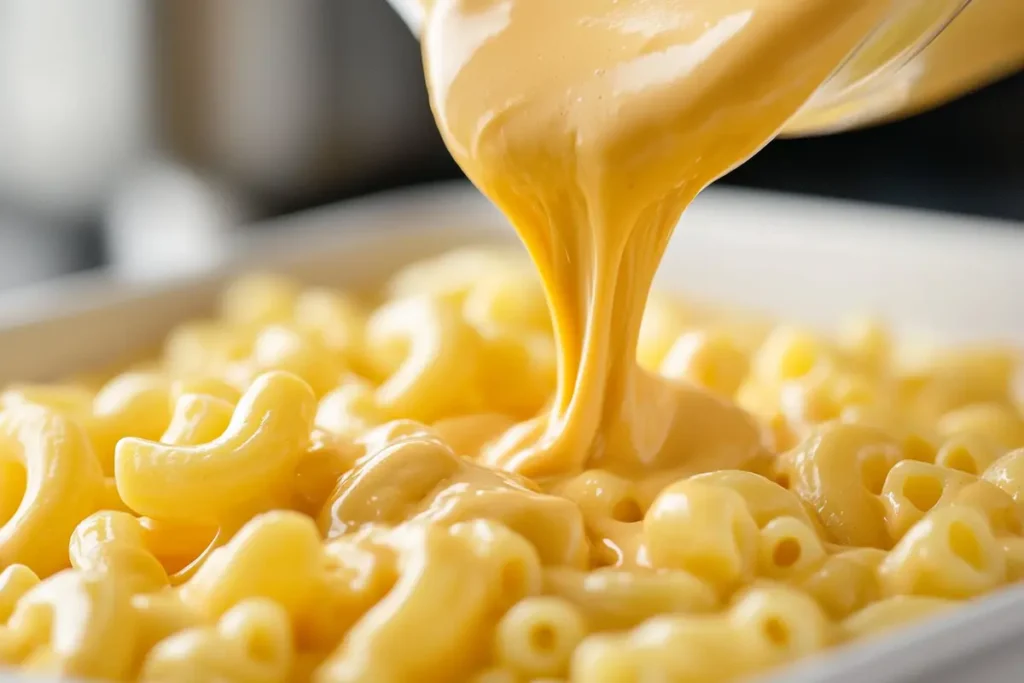
The cheese sauce is the heart and soul of old fashioned baked macaroni and cheese. It’s what makes the dish so creamy, flavorful, and comforting.
Making a Roux: Butter, Flour, and Technique
Start by melting butter in a medium saucepan over medium heat. Once melted, sprinkle in an equal amount of flour (usually 2-3 tablespoons each, depending on your recipe). Whisk continuously for 1-2 minutes to cook off the raw flour taste but avoid browning it. This mixture, known as a roux, acts as a thickening agent for your sauce.
Adding Milk and Cheese: Tips for Achieving a Creamy Consistency
Gradually pour in warm milk or a combination of milk and cream while whisking to ensure a lump-free sauce. Let the mixture simmer gently, stirring occasionally, until it begins to thicken.
Once the base is smooth, it’s time to add the cheese. Use freshly grated cheddar, Colby, Gruyère, or a mix of these for a balanced flavor profile. Add the cheese in batches, stirring until melted before adding more. This method prevents clumping and ensures a creamy consistency.
Balancing Flavors with Seasonings
Season your sauce with a pinch of salt, a dash of black pepper, and a hint of paprika or mustard powder for added depth. These subtle touches elevate the dish from ordinary to extraordinary. Taste and adjust the seasoning to your preference before assembling the dish.
Assembling and Baking
With the pasta cooked and the cheese sauce ready, it’s time to bring everything together for the ultimate baked macaroni and cheese experience.
Layering Pasta, Cheese Sauce, and Optional Toppings
In a greased baking dish, start by layering half of the cooked pasta. Pour half of the cheese sauce over it, ensuring every piece is coated. Repeat with the remaining pasta and sauce.
For an extra-special touch, sprinkle breadcrumbs mixed with a bit of melted butter over the top. This creates a crispy, golden-brown crust. Want to add a little more flair? Try a handful of extra grated cheese or a dusting of paprika for color.
Ideal Oven Temperature and Baking Time
Preheat your oven to 350°F (175°C). Bake the macaroni and cheese uncovered for 25-30 minutes, or until the topping is golden and the sauce is bubbling around the edges. Keep a close eye during the final few minutes to avoid over-browning.
Checking for Doneness
To check if your old fashioned baked macaroni and cheese is ready, insert a spoon into the center. The pasta should be hot and the sauce thick and creamy, not runny. Once baked to perfection, let it rest for 5-10 minutes before serving to allow the flavors to settle and the sauce to thicken further.
Popular Twists on Old Fashioned Baked Macaroni and Cheese
Adding Meats and Proteins
- Shredded Chicken: Tossing in pre-cooked, shredded chicken adds a lean protein that pairs beautifully with the creamy cheese sauce. A rotisserie chicken works wonderfully for convenience.
- Ground Turkey or Beef: Browned and seasoned ground turkey or beef can make the dish feel like a full meal. Be sure to drain any excess grease before adding it to your layers.
- Turkey Bacon: For a smoky crunch, sprinkle cooked, crumbled turkey bacon between the pasta and cheese layers. It’s a flavorful way to introduce a crispy texture without overpowering the dish.
Vegetarian and Vegan Adaptations
- Nut-Based Cheese Alternatives: Cashew-based or almond-based cheese substitutes melt beautifully and mimic the creaminess of traditional cheese.
- Plant-Based Butter and Milk: Swap dairy butter and milk for options like vegan butter and oat milk, which provide richness without compromising taste.
- Nutritional Yeast: For vegans, nutritional yeast offers a cheesy flavor while adding extra nutrients. Combine it with plant-based cheese for the ultimate creamy sauce.
Spicing It Up
- Jalapeños: Dice fresh or pickled jalapeños and stir them into the cheese sauce or sprinkle them on top before baking.
- Cayenne Pepper: A pinch of cayenne in the sauce provides a gentle kick of heat that balances the richness of the cheese.
- Hot Sauce: Add a few dashes of your favorite hot sauce for a tangy, spicy zing that livens up each bite.
FAQs About Old Fashioned Baked Macaroni and Cheese
Are you supposed to cover macaroni and cheese when you bake it?
No, you don’t typically cover macaroni and cheese while baking. Baking it uncovered allows the top layer—whether it’s cheese, breadcrumbs, or both—to develop a crispy, golden crust. If you cover the dish, you risk steaming the top layer, which can make it soggy. If you’re worried about over-browning, you can tent the dish with foil for the first 15 minutes and then bake it uncovered.
What Are the Best Cheeses for Macaroni and Cheese?
The best cheeses for macaroni and cheese are those that melt smoothly and provide bold flavor. Sharp cheddar is the classic choice due to its rich taste and creamy texture. To elevate the dish, blend cheddar with other cheeses like Gruyère, which melts beautifully and adds nuttiness, or Colby Jack for a milder, creamier touch.
Why is Cracker Barrel mac and cheese so good?
Cracker Barrel’s mac and cheese stands out because it uses high-quality sharp cheddar cheese, giving the dish a bold, tangy flavor. The sauce is rich and creamy, with just the right balance of seasonings. Additionally, the dish is baked to perfection, ensuring a satisfying crispy topping. You can replicate a similar flavor by using sharp cheddar and layering your dish with care.
How Do I Prevent the Sauce from Becoming Grainy?
Grainy cheese sauce often results from overheating the cheese or using pre-shredded cheese with anti-caking agents. To prevent this, always shred cheese fresh from the block and stir it into the sauce over low heat. Gradually adding the cheese and whisking consistently helps maintain a smooth texture. Avoid boiling the sauce, as high heat can cause the cheese to separate.
What are the three best cheeses for mac and cheese baked?
For a perfect blend of flavor and creaminess in baked macaroni and cheese, try combining sharp cheddar, Gruyère, and Monterey Jack. Sharp cheddar brings boldness, Gruyère adds a subtle nuttiness, and Monterey Jack delivers a smooth, melty texture. This trio ensures your dish is both rich and indulgent.
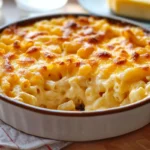
Old Fashioned Baked Macaroni and Cheese Recipe: Classic Comfort Food
- Total Time: 45 minutes
- Yield: 6 servings 1x
- Diet: Vegetarian
Ingredients
For the Macaroni and Cheese:
- 2 cups elbow macaroni (or pasta of your choice)
- 4 tablespoons unsalted butter
- 4 tablespoons all-purpose flour
- 2 cups whole milk
- 1 cup heavy cream
- 2 ½ cups sharp cheddar cheese, freshly shredded (divided)
- ½ cup Gruyère cheese, freshly shredded
- ½ teaspoon salt
- ¼ teaspoon black pepper
- ½ teaspoon dry mustard powder (optional)
- ¼ teaspoon paprika (optional, for added flavor)
For the Topping:
- ½ cup panko breadcrumbs
- 2 tablespoons unsalted butter, melted
- ¼ cup sharp cheddar cheese, shredded (optional, for extra cheesiness)
Instructions
1. Preheat the Oven
- Preheat your oven to 350°F (175°C). Grease a 9×13-inch baking dish with butter or non-stick spray and set it aside.
2. Cook the Pasta
- Bring a large pot of salted water to a boil.
- Add the elbow macaroni (or your preferred pasta) and cook until al dente, usually 1-2 minutes less than the package instructions.
- Drain the pasta and set it aside. Toss with a little butter or oil to prevent sticking.
3. Make the Roux (Cheese Sauce Base)
- In a medium saucepan, melt 4 tablespoons of butter over medium heat.
- Whisk in 4 tablespoons of flour and cook for 1-2 minutes, stirring continuously. This step removes the raw taste of the flour.
- Gradually pour in 2 cups of milk and 1 cup of heavy cream, whisking constantly to avoid lumps. Cook for 3-4 minutes until the sauce thickens and coats the back of a spoon.
4. Add the Cheese and Seasonings
- Lower the heat and slowly stir in 2 cups of sharp cheddar cheese and ½ cup of Gruyère cheese, a handful at a time. Whisk until melted and smooth.
- Season the sauce with salt, pepper, mustard powder, and paprika (if using). Taste and adjust as needed.
5. Combine Pasta and Cheese Sauce
- Pour the cooked pasta into the cheese sauce and stir until the macaroni is fully coated.
6. Assemble the Dish
- Transfer the cheesy macaroni into the greased baking dish, spreading it evenly.
- Sprinkle ½ cup of sharp cheddar cheese over the top for extra cheesiness (optional).
7. Prepare the Topping
- In a small bowl, combine ½ cup of panko breadcrumbs with 2 tablespoons of melted butter. Mix well to coat the breadcrumbs evenly.
- Sprinkle the breadcrumb mixture evenly over the top of the macaroni.
8. Bake to Perfection
- Place the dish in the preheated oven and bake for 25-30 minutes, or until the top is golden brown and bubbly.
- For an extra crispy crust, broil the dish for 1-2 minutes at the end, keeping a close eye to prevent burning.
9. Rest and Serve
- Let the macaroni and cheese cool for 5-10 minutes before serving. This allows the sauce to set slightly, ensuring every bite is creamy and delicious.
- Prep Time: 15 minutes
- Cook Time: 30 minutes
- Category: Main Dish or Side Dish
- Method: Baking
- Cuisine: American
Nutrition
- Serving Size: 1/6 of the dish
- Calories: 450
- Sugar: 4g
- Sodium: 550mg
- Fat: 25g
- Saturated Fat: 15g
- Unsaturated Fat: 8g
- Trans Fat: 0g
- Carbohydrates: 38g
- Fiber: 1.5g
- Protein: 16g
- Cholesterol: 70mg
Keywords: Classic baked macaroni and cheese, Homemade mac, and cheese recipe, Creamy pasta casserole
